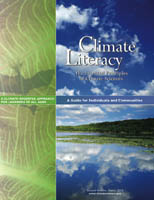Toward a Climate-Literate Citizenry: An Interview with Frank Niepold

-
Frank Niepold of NOAA
Frank Niepold is currently a Climate Education Coordinator for the Climate Program Office at the National Oceanic and Atmospheric Administration (NOAA) in Silver Spring, Maryland, and the co-chair of the Education Interagency Working Group (EdIWG) at the U.S. Global Change Research Program (USGCRP). At NOAA, he develops and implements NOAA’s Climate Goal education and outreach efforts. As a co-chair of the interagency working group, he coordinates an integrated national approach to climate change education.
Nielpold is a co-managing author of Climate Literacy: The Essential Principles of Climate Science. The result of a collaborative effort of NOAA, the National Science Foundation (NSF), NASA, AAAS Project 2061, CIRES (Cooperative Institute for Research in Environmental Sciences), the American Meteorological Society, and various members of both the science and education communities, the guide helps to define climate literacy for U.S. citizens.
Niepold has worked closely with Project 2061 since 2006, when he organized a review team for the weather and climate strand maps during the development of Atlas of Science Literacy, Volume 2. That work led to a 2007 Project 2061 workshop, funded by NOAA, to begin the process of defining climate literacy. Niepold currently serves on the advisory group for the AAAS Conference on Promoting Climate Literacy through Informal Science to be held February 2010.
Project 2061 recently interviewed Mr. Niepold via e-mail about his work on behalf of climate science literacy.
Project 2061: What are NOAA’s main goals for climate education? Who are your audiences?
Niepold: The Climate Program Office (CPO), housed within NOAA’s Office of Oceanic and Atmospheric Research (OAR), conducts a Communication and Education Program (Climate CommEd) whose missions are to improve public climate science literacy and to raise public awareness and understanding of, and engagement with, NOAA’s climate science and services programs. The Climate CommEd was formed in 2008 and embarked on a multi-pronged new initiative to produce and distribute a range of products, conduct programs, and collaborate in partnerships.
Climate CommEd works in close alignment with the agency’s overarching Strategic Plans for Communications, Education, and Engagement. Each of these plans was recently updated, driven by three main factors: (1) NOAA’s ongoing Congressional mandates (including the recent America Competes Act) to communicate with, and educate, the public about its sciences and services programs; (2) NOAA senior management’s placement of climate science and services at the top of the agency’s priority list; and (3) the recent Science Advisory Board (SAB) feedback that NOAA must expand and improve the way it trains, educates, communicates, and conducts extension to meet the nation’s needs.
In addition to reaching educators, including both formal and informal science educators, Climate CommEd also works with decision makers and policy leaders, scientists and users of NOAA’s climate research data, and various groups within the public. Depending on the group, our goal is to convey information, to engage members of the group more actively, to educate through collaborative programs designed to meet curriculum standards and/or civic science literacy goals, or to provide professional development to help professional data users and decision makers in their work.
Project 2061: How does NOAA define “climate science literacy”? How does it relate to science literacy in general as envisioned in AAAS Project 2061’s Science for All Americans?
Niepold: NOAA has worked to define climate literacy by engaging a large cross section of the education and science community to come to a common definition. This process began with a NOAA grant to AAAS Project 2061 to conduct a three-day workshop in April of 2007. At this workshop, we used the AAAS Project 2061 work of the last 15 years to begin the process of defining climate literacy. Science for All Americans served as the basis for much of this work, but at the time of its development the climate science of that day was not as robust. To address this, NOAA worked with AAAS Project 2061 on the development of the Atlas for Science Literacy, Volume 2 and then on the AAAS Communicating and Learning About Global Climate Change guide in 2008.
Here’s the main definition of climate literacy from the 2009 Climate Literacy: The Essential Principles of Climate Science guide:
Climate Science Literacy is an understanding of your influence on climate and climate’s influence on you and society. A climate-literate person
- understands the essential principles of Earth’s climate system,
- knows how to assess scientifically credible information about climate,
- communicates about climate and climate change in a meaningful way, and
- is able to make informed and responsible decisions with regard to actions that may affect climate.
The guide goes on to describe how becoming literate in climate science contributes to science literacy and is an ongoing learning process. I encourage your readers to take a look at the guide for themselves, at http://www.globalchange.gov/resources/educators/climate-literacy.
Project 2061: Can you tell us more about Climate Literacy: The Essential Principles of Climate Science and how it was developed? How is it being used?
Niepold: Development of the guide began at the NOAA and Project 2061 workshop that I’ve already mentioned. When the guide was first released in March of 2008, it was considered to be a NOAA product. The community treated it as such resulting in its limited use. To support the development and use of the 2008 guide, a “Climate Literacy Network” was formed. This network and the federal partners—NOAA, the Environmental Protection Agency, and the U.S. Forestry Service—agreed to expand the scope of the partners to include more non-governmental organization partners and federal agencies.
As a part of this process, NASA requested that we seek the approval of the U.S. Climate Change Science Program, now the U.S. Global Change Research Program (USGCRP), so that the document would no longer be seen as a NOAA effort alone. The USGCRP accepted the document, acknowledging the role it could play in the work of the Education Interagency Working Group, which helps to coordinate an integrated national approach to climate change education.
This Working Group promotes synergy between the different agencies’ education activities so that we can address the national need for climate education that goes beyond the missions of individual agencies. A key part of this effort is the guide. It was approved by the USGCRP in February of 2009 and serves to guide NASA, NSF, and NOAA education grants. In fiscal year 2009, more than $30 million in grants went to climate change directly; perhaps as much as $50 million more went to climate change education, and the agencies used the guide in their planning.
Project 2061: Given your experience in working with Project 2061 on behalf of climate education, what do you see as the most important areas in which the Project can make a contribution? What role would you like to see Project 2061 play in the future?
Niepold: Project 2061 is making very significant contributions to this critical issue. The current work on benchmark clarification, phenomenon and representation identification, and educational assessment is critical to the long-term reform required in education. The nation must protect fragile ecosystems and build sustainable communities that are resilient to climate change—including extreme weather and climate events. For this a climate-literate citizenry is essential.
That said, Project 2061 has also been a key partner in a variety of reform efforts to achieve these goals. As a partner on the NSF-funded Climate Literacy Energy Awareness Network (CLEAN), which is a National Science Digital Library (NSDL) Pathways grant starting in January 2010, they continue to be key partners for NOAA and the climate literacy effort. (Learn more about Project 2061’s NSDL projects.) Project 2061 has also just received one of the five Environmental Literacy grants from NOAA and will be developing phenomena and representations for teaching weather and climate in middle-school science.
Project 2061: What message do you have for K–12 science teachers and informal science educators about climate change?
Niepold: The main message I have is that actions taken by individuals, communities, states, and countries all influence climate. Practices and policies followed in homes, schools, businesses, and governments can affect climate. Climate-related decisions made by one generation can provide opportunities as well as limit the range of possibilities open to the next generation. Steps toward reducing the impact of climate change may influence the present generation by providing other benefits such as improved public health infrastructure and sustainable built environments.
# # #
Learn more about NOAA’s Climate CommEd Program.
Read Climate Literacy: The Essential Principles of Climate Science.
Access AAAS’s Communicating and Learning About Global Climate Change.
For additional information, please contact:
Communications Director: Mary Koppal, (202) 326-6643
Also in the September/October 2009 issue:





